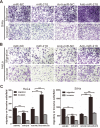MicroRNA-218 inhibits EMT, migration and invasion by targeting SFMBT1 and DCUN1D1 in cervical cancer
- PMID: 27285984
- PMCID: PMC5216747
- DOI: 10.18632/oncotarget.9850
MicroRNA-218 inhibits EMT, migration and invasion by targeting SFMBT1 and DCUN1D1 in cervical cancer
Abstract
Repeated infection with high-risk HPV is a major cause for the development and metastasis of human cervical cancer, even though the mechanism of the metastasis is still not completely understood. Here, we reported that miR-218 (microRNA-218) was downregulated in cervical cancer tissues, especially in metastatic cancer tissues. We found that miR-218 expression was associated with clinicopathological characteristics of patients with cervical cancer. MiR-218 overexpression inhibited Epithelial-Mesenchymal Transition (EMT), migration and invasiveness of cervical cancer cells in vitro. Moreover, miR-218 repressed the expression of SFMFBT1 (Scm-like with four MBT domains 1) and DCUN1D1 (defective in cullin neddylation 1, domain containing 1) by direct binding to the 3'UTRs of the mRNAs. The overexpression of SFMBT1 induced EMT and increased the migration and invasiveness of cervical cancer cells, while the overexpression of DCUN1D1 increased the migration and invasiveness of these cells, but did not induce EMT. An inverse correlation was observed between the expression of miR-218 and DCUN1D1 protein in cervical cancer tissues. Importantly, HPV16 E6 downregulated the expression of miR-218 in cervical cancer, while miR-218 rescued the promotion effect of HPV16 E6 on the expression of SFMBT1 and DCUN1D1. Taken together, our results revealed that HPV16 E6 promoted EMT and invasion in cervical cancer via the repression of miR-218, while miR-218 inhibited EMT and invasion in cervical cancer by targeting SFMBT1 and DCUN1D1.
Keywords: DCUN1D1; EMT; SFMBT1; cervical cancer; miR-218.
Conflict of interest statement
The authors declare no conflicts of interest.
Figures







Similar articles
-
MicroRNA‑195 inhibits cell proliferation, migration and invasion by targeting defective in cullin neddylation 1 domain containing 1 in cervical cancer.Int J Mol Med. 2018 Aug;42(2):779-788. doi: 10.3892/ijmm.2018.3660. Epub 2018 May 8. Int J Mol Med. 2018. Retraction in: Int J Mol Med. 2021 Jul;48(1):140. doi: 10.3892/ijmm.2021.4973. PMID: 29750306 Free PMC article. Retracted.
-
Human papillomavirus oncoproteins differentially modulate epithelial-mesenchymal transition in 5-FU-resistant cervical cancer cells.Tumour Biol. 2016 Oct;37(10):13137-13154. doi: 10.1007/s13277-016-5143-6. Epub 2016 Jul 24. Tumour Biol. 2016. PMID: 27449048
-
microRNA-145 modulates epithelial-mesenchymal transition and suppresses proliferation, migration and invasion by targeting SIP1 in human cervical cancer cells.Cell Oncol (Dordr). 2017 Apr;40(2):119-131. doi: 10.1007/s13402-016-0307-3. Epub 2016 Dec 8. Cell Oncol (Dordr). 2017. PMID: 27933466
-
MicroRNA-124 inhibits proliferation, invasion, migration and epithelial-mesenchymal transition of cervical carcinoma cells by targeting astrocyte-elevated gene-1.Oncol Rep. 2016 Oct;36(4):2321-8. doi: 10.3892/or.2016.5025. Epub 2016 Aug 17. Oncol Rep. 2016. PMID: 27571703
-
The role of miRNAs in the invasion and metastasis of cervical cancer.Biosci Rep. 2019 Mar 15;39(3):BSR20181377. doi: 10.1042/BSR20181377. Print 2019 Mar 29. Biosci Rep. 2019. PMID: 30833362 Free PMC article. Review.
Cited by
-
MicroRNA-132 inhibits migration, invasion and epithelial-mesenchymal transition via TGFβ1/Smad2 signaling pathway in human bladder cancer.Onco Targets Ther. 2019 Jul 23;12:5937-5945. doi: 10.2147/OTT.S201731. eCollection 2019. Onco Targets Ther. 2019. PMID: 31413591 Free PMC article.
-
Circular RNA hsa_circ_0000515 acts as a miR-326 sponge to promote cervical cancer progression through up-regulation of ELK1.Aging (Albany NY). 2019 Nov 26;11(22):9982-9999. doi: 10.18632/aging.102356. Epub 2019 Nov 26. Aging (Albany NY). 2019. PMID: 31772143 Free PMC article.
-
Potential role of micro ribonucleic acids in screening for anal cancer in human papilloma virus and human immunodeficiency virus related malignancies.World J Gastrointest Pathophysiol. 2021 Jul 22;12(4):59-83. doi: 10.4291/wjgp.v12.i4.59. World J Gastrointest Pathophysiol. 2021. PMID: 34354849 Free PMC article. Review.
-
MicroRNA-218-5p Promotes Endovascular Trophoblast Differentiation and Spiral Artery Remodeling.Mol Ther. 2018 Sep 5;26(9):2189-2205. doi: 10.1016/j.ymthe.2018.07.009. Epub 2018 Jul 12. Mol Ther. 2018. PMID: 30061037 Free PMC article.
-
MicroRNA-520b Functions as a Tumor Suppressor in Colorectal Cancer by Inhibiting Defective in Cullin Neddylation 1 Domain Containing 1 (DCUN1D1).Oncol Res. 2018 May 7;26(4):593-604. doi: 10.3727/096504017X14920318811712. Epub 2017 May 4. Oncol Res. 2018. PMID: 28470146 Free PMC article.
References
-
- Jemal A, Bray F, Center MM, Ferlay J, Ward E, Forman D. Global Cancer Statistics. Ca-a Cancer Journal for Clinicians. 2011;61:69–90. - PubMed
-
- Gupta GP, Massague J. Cancer metastasis: Building a framework. Cell. 2006;127:679–695. - PubMed
-
- Lee RC, Feinbaum RL, Ambros V. The C. elegans heterochronic gene lin-4 encodes small RNAs with antisense complementarity to lin-14. Cell. 1993;75:843–854. - PubMed
-
- Calin GA, Croce CM. MicroRNA signatures in human cancers. Nature Reviews Cancer. 2006;6:857–866. - PubMed
-
- Fanini F, Vannini I, Amadori D, Fabbri M. Clinical Implications of MicroRNAs in Lung Cancer. Seminars in Oncology. 2011;38:776–780. - PubMed
MeSH terms
Substances
LinkOut - more resources
Full Text Sources
Other Literature Sources
Medical

